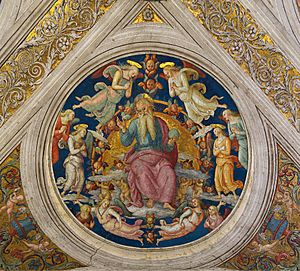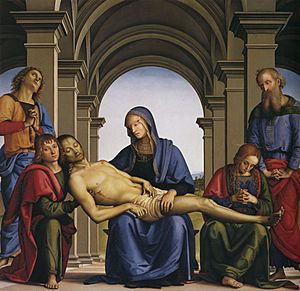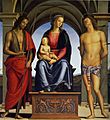Pietro Perugino facts for kids
Quick facts for kids
Pietro Perugino
|
|
|---|---|

Self-portrait, 1497–1500
|
|
| Born |
Pietro Vannucci
c. 1446 Città della Pieve, Papal States (now Umbria, Italy)
|
| Died | 1523 (aged 76–77) Fontignano, Papal States (now Umbria, Italy)
|
| Nationality | Italian |
| Education | Andrea del Verrocchio |
| Known for | Painting, fresco |
|
Notable work
|
The Delivery of the Keys |
| Movement | Italian Renaissance |
Pietro Perugino (born around 1446 – died 1523) was a very important Italian painter. He was a leader of the Umbrian school of painting. His work helped shape the style of the High Renaissance, a famous period in art. Perugino was also one of the teachers of the famous artist Raphael.
Contents
Early Life and Training
Pietro Perugino was born Pietro Vannucci in Città della Pieve, a town in Umbria, Italy. His nickname, Perugino, means "from Perugia," which was the main city in Umbria. We don't know his exact birth date, but it was likely between 1446 and 1452.
Pietro probably started learning to paint in workshops in Perugia. Later, he moved to Florence, a major art city. There, he trained in the workshop of Andrea del Verrocchio. Other famous artists like Leonardo da Vinci and Domenico Ghirlandaio also trained there. Pietro also learned about perspective (making things look 3D) from Piero della Francesca. By 1472, he was a master painter.
Perugino was one of the first Italian artists to use oil paints. He created many large wall paintings, called frescoes. One of his early works was a circular painting called a tondo (which means "round" in Italian). It showed the Virgin Mary and Child with Saints. This painting is now in the Musée du Louvre in Paris.
Painting in Rome
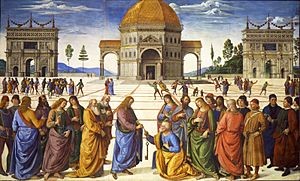
Around 1480, Pope Sixtus IV invited Perugino to Rome. The Pope wanted him to paint frescoes on the walls of the Sistine Chapel. This chapel is now famous for Michelangelo's later paintings.
Perugino painted several important frescoes in the Sistine Chapel. These included Moses and Zipporah, the Baptism of Christ, and his most famous work there, The Delivery of the Keys. Another artist, Pinturicchio, worked with Perugino in Rome. Some of Perugino's frescoes on the altar wall were later removed to make space for Michelangelo's Last Judgment.
After his time in Rome, Perugino worked mostly in Florence. He also traveled back to Perugia often. He had a busy studio in Florence and received many art jobs. His painting Pietà (1483–1493) is a powerful work that shows Mary mourning over Jesus.
In 1493, Perugino married Chiara, the daughter of an architect. Florence became his main home again, though he still took on work in other cities.
Later Career and Famous Works
In 1499, a group of bankers in Perugia asked Perugino to decorate their meeting hall. This hall is called the Sala delle Udienze del Collegio del Cambio. He painted the ceiling with planets and zodiac signs. On the walls, he painted religious scenes like the Nativity and the Transfiguration. He also painted figures of important people, prophets, and wise women. Perugino even included a self-portrait of himself in the hall. It is believed that Raphael, who was Perugino's student around 1496, might have helped with some of the ceiling paintings.
In 1501, Perugino became one of the leaders of Perugia. Around this time, the famous artist Michelangelo told Perugino that he was not a very good artist. Perugino was upset and tried to sue Michelangelo, but he lost. This made Perugino work even harder. He created the masterpiece Madonna and Saints for the Certosa of Pavia. Parts of this painting are now in different museums, including the National Gallery, London.
Later, Pope Julius II asked Perugino to paint a room in the Vatican City. However, the Pope soon preferred the younger artist Raphael, who had been Perugino's student. Perugino painted the ceiling of the room with figures of God the Father before he left Rome in 1512.
Perugino's later works sometimes repeated earlier ideas. However, he still created some beautiful pieces. One of his best later works was a large altarpiece for the church of San Agostino in Perugia (painted between 1512 and 1517).
His last frescoes were painted in churches in Trevi (1521) and Fontignano (1522). Perugino died in Fontignano in 1523 from the Black Death (a plague). Like other plague victims, he was quickly buried in an unmarked field.
In 1494, Perugino painted a self-portrait, which is now in the Uffizi Gallery. In this painting, he included a scroll that said Timete Deum (Fear God). This was interesting because some people said he didn't have strong religious beliefs. The portrait shows a man with a full face, small dark eyes, and a strong look.
Among his many students were the famous Raphael, Pompeo Cocchi, Eusebio da San Giorgio, Mariano di Eusterio, and Giovanni di Pietro.
Monuments
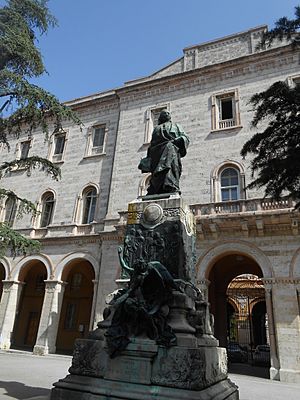
The city of Perugia built a special monument to Pietro Perugino in 1923. It was created by the sculptor Enrico Quattrini and can be seen in the Carducci Gardens today.
Images for kids
See also
 In Spanish: Pietro Perugino para niños
In Spanish: Pietro Perugino para niños


